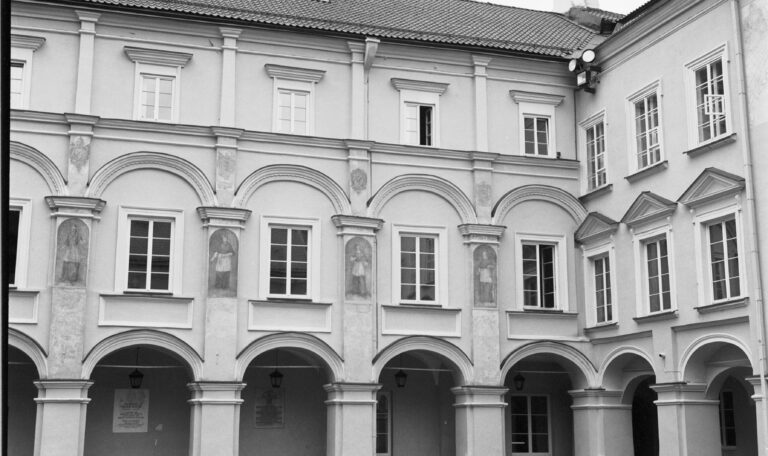In the 14th century, Grand Duke Gediminas invited craftsmen, merchants, and monks from Western Europe to settle in Vilnius, laying the foundations for the city’s future architectural diversity. Gothic architecture began to spread in the late 14th century, gaining prominence after the Christianisation of Lithuania in 1387, which saw the construction of Vilnius’ first Gothic cathedral. The Gothic style, flourishing until the 16th century, is characterised by red burnt brick masonry, decorative profile bricks, pointed arches, towers, and various types of vaulting (cross-ribbed, star, and net). Key Gothic buildings in Vilnius’ Old Town include St. Nicholas Church, the Church of the Assumption of the Blessed Virgin Mary (Franciscan Church), the ensemble of St. Anne’s and Bernardine Churches and Monastery, the Church of the Mother of God (with uncovered Gothic fragments), and a residential house at Pilies Street 12.
The Renaissance reached Vilnius in the 16th century, with the influence of Bona Sforza, wife of Sigismund the Old, who brought Italian architects, artists, musicians, and chefs, infusing Renaissance spirit into local culture. Important buildings were often designed by Italian architects. Renaissance buildings are distinguished by classical forms, arcaded galleries, attics, grey and white plastered walls, and sgraffito ornaments. Key Renaissance buildings in Vilnius’ Old Town include the Alumnate, the Radziwiłł Palace, the Small Guild, the Gates of Dawn, parts of Vilnius University, and the reconstructed Palace of the Grand Dukes.
Baroque, which succeeded the Renaissance in the late 16th century, was introduced by Jesuits who built ornate Baroque churches and monasteries following Italian examples. This style, flourishing in the 17th and 18th centuries, is characterised by rich decoration, intricate details, and grand volumes. Thanks to architect Johann Christoph Glaubitz, who worked in Vilnius in the mid-18th century, a distinctive Vilnius Baroque school emerged, influencing the region’s architecture. Key Baroque examples include St. Casimir’s Church, St. Theresa’s Church, St. Casimir’s Chapel, St. John’s Church and its belfry, St. Catherine’s Church, the Church of the Ascension of the Lord (Missionaries), the Church of the Holy Spirit (Orthodox), the Church of the Holy Spirit (Dominican), and the Holy Trinity Church and Gates (Basilian).
The Classicism style in Vilnius is inseparable from the works of architect Laurynas Gucevičius. After studying in Rome and Paris, Gucevičius returned to Vilnius, transforming its architectural landscape with symmetrical forms and classical proportions. His most significant buildings, still standing today, are Vilnius Town Hall and the Cathedral. Classicism, derived from ancient architecture, is marked by harmonious proportions and symmetry. Other key examples of Classicist architecture include the Presidential Palace, the Chodkiewicz Palace (Vilnius Picture Gallery), and several other 18th-century palaces.
In the 19th century, Historicism appeared in Vilnius, a style that revived and combined elements of previous architectural periods. Notable examples of Historicism include the National Philharmonic, St. Nicholas Orthodox Church, the buildings at Gediminas Avenue 6 (Bank of Lithuania), Gediminas Avenue 7 (ISM School), and the Štral House (Pilies Street 26).

Photo: Gediminas Pranckūnas
